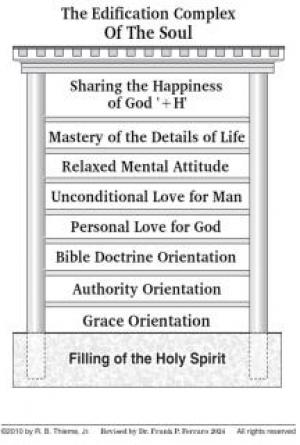FOOTNOTES:
1 CT omits "and fasting" which is found in Byzantine manuscripts including PT. (E.O.B.)
2 God’s Word in Romania, translated by I. A., redactor note.
3 The Army of the Lord, (Romanian: Oastea Domnului), is a spiritual and moral renewal movement in Romania founded, in 1922, by Fr. Joseph Trifa, a Romanian Orthodox priest. (The first apocalyptic trumpet See selection topic: "The apocalyptic trumpets", r.n.) Fr. Trifa defined the Army of the Lord as a voluntary lay grassroots organization based on the Bible for revitalizing the Romanian Orthodox Church. After 1948, the movement was declared illegal by the communist regime.
4 Aerial Toll-Houses
5 The Shrove Sunday represents a celebration what means the last day when one can eat "for sweet", before starting one of the four great fastings established in the Orthodox Church (The Fasting of the Nativity, the Fasting of the Holy Passover, the Fasting of the Saints Apostles Peter and Paul, and the Fasting of the Assumption), r.n.
6 The churchly calendar by 1924 was the same with the one from Nicaea, having at its base severe apostolic canons, but in 1924, the Scripture of the prophet Daniel was fulfilled: "people will make bold to change the times", when pre-eminence Metropolitan of that time, Miron Cristea, introduced the Gregorian (Catholic) Calendar as a result of a congress "Pan-Orthodox", held in 1923 in Constantinople. At that congress, the patriarch of that time, Meletie, proposes the acceptance of the "revised" Julian calendar, which coincides with the Catholic one for a period as long as to 2800 and "it was allowing that all the feasts to be celebrated with those of other denominations", r.n.
7 "God also said, 'Look, to you I give all the seed-bearing plants everywhere on the surface of the earth, and all the trees with seed-bearing fruit; this will be your food. " (Gen. 1/29.)
8 Old Style (O.S.) and New Style (N.S.) (http://en.wikipedia.org/wiki/Old_Style_and_New_Style_dates) are sometimes used with dates to indicate either whether the start of the Julian year has been adjusted to start on 1 January (N.S.) even though documents written at the time use a different start of year (O.S.), or whether a date conforms to the Julian calendar (O.S.), formerly in use in many countries, rather than the Gregorian (N.S.)
The Church Calendar (in Romania) up to 1924 was the same as that of Nicaea, based on severe apostolic canons, but in 1924, the Scripture of the prophet Daniel was fulfilled: "the people made bold to even change the times", when the primate metropolitan - of that time, Miron Cristea, (Primate metropolitan = (in the past) a title given to the first metropolitan of a country; today it would be equal to that of a patriarch) introduced the Gregorian Calendar (Catholic) as result of a "pan-Orthodox" congress that took place in 1923, in Constantinople. At that congress, the patriarch of that time, Meletie, proposed the acceptance of the "revised" Julian Calendar, (http://en.wikipedia.org/wiki/Revised_Julian_calendar) which was in accord with the Catholic one for a period up to the year 2800 and "it was allowing that all the feasts to be celebrated at the same time with those of other confessions". "… and he shall wear out the saints of the Most High and he shall think to change the times and the law…" (Daniel 7/25), r.n.
9 "God also said, 'Look, to you I give all the seed-bearing plants everywhere on the surface of the earth, and all the trees with seed-bearing fruit; this will be your food. " (Gen. 1/29.)
10 "God said, "Behold, I have given you every herb yielding seed, which is on the surface of all the earth, and every tree, which bears fruit yielding seed. This will be your food." (Gen: 1/29)
11 "God also said, 'Look, to you I give all the seed-bearing plants everywhere on the surface of the earth, and all the trees with seed-bearing fruit; this will be your food". (Gen: 1/29.)
12 "But the Counselor, the Holy Spirit whom the Father will send in My Name, will teach you all things and remind you of all that I said to you". (John: 14/26)
13 Or "when you practice righteousness" (EOB)
14 About candle and oil significance see The Word of God at the Feast of the Church Entrance of the Lord’s Mother, on 04-12-1995 (On Slideshare; on Issuu; on Google Drive)
15 Old Style (O.S.) and New Style (N.S.) (http://en.wikipedia.org/wiki/Old_Style_and_New_Style_dates) are sometimes used with dates to indicate either whether the start of the Julian year has been adjusted to start on 1 January (N.S.) even though documents written at the time use a different start of year (O.S.), or whether a date conforms to the Julian calendar (O.S.), formerly in use in many countries, rather than the Gregorian (N.S.)
The Church Calendar (in Romania) up to 1924 was the same as that of Nicaea, based on severe apostolic canons, but in 1924, the Scripture of the prophet Daniel was fulfilled: «the people made bold to even change the times», when the primate metropolitan - of that time, Miron Cristea, (Primate metropolitan = (in the past) a title given to the first metropolitan of a country; today it would be equal to that of a patriarch) introduced the Gregorian Calendar (Catholic) as result of a „pan-Orthodox” congress that took place in 1923, in Constantinople. At that congress, the patriarch of that time, Meletie, proposed the acceptance of the „revised” Julian Calendar, (http://en.wikipedia.org/wiki/Revised_Julian_calendar) which was in accord with the Catholic one for a period up to the year 2800 and „it was allowing that all the feasts to be celebrated at the same time with those of other confessions”. «… and he shall wear out the saints of the Most High and he shall think to change the times and the law…» (Daniel 7/25), r.n.







